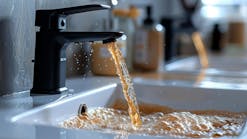Gary Strunak is director of national sales for Tomlinson Ind. Strunak can be reached at [email protected] or 216.587.3400 ext. 221.
Point-of-use (POU) faucets and systems are becoming important in helping meet consumer demands for safe, high quality drinking water. Water treatment systems can require faucets in a variety of styles and finishes.
Amendments to the Federal Safe Drinking Water Act required faucets and other endpoint plumbing devices to comply with the low lead requirements of NSF/ANSI Standard 61 Section 9 by August 1998. Some of the products covered include drinking fountains, water coolers, hot water dispensers, glass fillers, kitchen and lavatory faucets, as well as residential refrigerator icemakers.
Faucet Features
Faucets for POU, reverse osmosis (RO) and other water treatment systems are available in either an air-gap or non-air gap version. The air-gap style provides protection from back-siphonage. Back-siphonage is the flowing back of used, contaminated or polluted water from a plumbing fixture or vessel into a water supply pipe due to a negative pressure in the pipe.
POU faucets usually are available in different styles and finishes to compliment or match a specific décor. Some of the most popular finishes are venetian bronze, antique bronze, matte black, satin nickel, brushed stainless and polished nickel. Some POU faucets feature an ergonomic handle, a stream straightener, a protective tip and goosenecks that easily swivel. The faucets should have a maximum temperature rating of 150ºF and a maximum pressure rating of 120 psi to efficiently dispense the treated water.
Decorative or designer faucets for RO and water treatment systems can be an opportunity to up-sell. These faucets must be NSF listed to NSF/ANSI Standard 61-9 & 372, which ensures the faucet meets the lead-free requirements of state and federal laws.
Targeting lead. An unsafe level of lead in drinking water is an ongoing issue. This situation can occur as a result of lead pipes or fixtures that have lead solder. Unsafe lead levels have been found in older drinking water systems. The U.S. EPA recommends that lead levels in drinking water be below 15 ppb. Lead-free faucets are an answer to lead problems occurring in older drinking water equipment and systems in public areas, such as restaurants, hotels, parks and schools.
The faucets used on indoor and outdoor drinking water fountains can either be bubbler style or projector head. The bubbler incorporates the activator button right into the faucet, which controls the flow. The projector head allows for the activator button to be located away from where the water is being dispensed, such as on the side of the cooler or fountain. This is quite common. The projector head provides the flow characteristics for drinking. An option available with a projector head is a set screw that allows for protection from vandals. This is popular with outdoor fountains. Bubblers and projector heads should be lead-free and NSF-certified.
Fountain glass fillers. Fountain glass fillers feature lead-free brass construction with a chrome-plated finish and a lever-actuated flow. The internal design provides a smooth flow through a wide range of pressures without the need for a flow-control design. Dispensing styles include push down, push back or cup trip. A vertical mount glass filler also is an option. Fountain glass fillers should have a maximum pressure rating of 120 psi.
POU coolers. POU water coolers attach directly to the water source and never require filling or replenishing. A hidden reservoir assures that there always is cold, hot or room-temperature water available. A variety of sizes are available, ranging from countertop models to larger floor model drinking water fountains. Both floor models and wall-mounted models are available in a variety of styles, sizes and configurations, including barrier-free coolers that allow for complete accessibility for wheelchairs. Some water coolers use foot pedals to activate the water flow. Both innovations have increased the number of uses and users of POU water coolers.
Some POU water systems use plastic cooler faucets. These faucets should be lead-free and made of U.S. Food and Drug Adminstration- (FDA) grade polypropylene. These materials do not distort or affect the taste of the water being dispensed. The faucets should be NSF-listed and many are available in a variety of colors. Optional handles, including a cup trip style for one-hand dispensing and a safety handle design to help prevent accidental dispensing, can enhance the unit.
Hot Water Dispensing. Other applications for POU faucets are hot water dispensing units, coffee brewers and coffee urns where water lines are plumbed directly into the unit. These faucets dispense hot water and are made of chromed brass. Both gravity and high-pressure faucets are available. Most faucets are NSF-listed and can be supplied with safety-style handles to prevent accidental dispensing. Some high-pressure faucets come standard with a safety clip and aerator for a smooth, controlled flow. When required, a spout extension can be installed on the metal faucets to ensure control.
Making a Choice
The key to faucet selection is safety. Avoid the inexpensive, leaded brass styles for any RO or bubbler-style applications. The materials used in all units, from basic to high-end, must meet requirements, such as FDA-grade materials and NSF listings, on all models. NSF certification ensures that the design and materials used provide safe products. Considerations also can revolve around aesthetics, such as which style and color are best suited for a specific product or location.
In the near future, all consumers will demand purified and filtered water. The consumer will choose how and where that water is treated. Consumers already are choosing to install POU systems and point-of-entry (POE) whole-house systems to obtain quality water. With the threat of contamination of municipal water treatment plants, POU/POE water treatment and filtering systems will continue to be a means to ensure safe and pure drinking water within homes.



